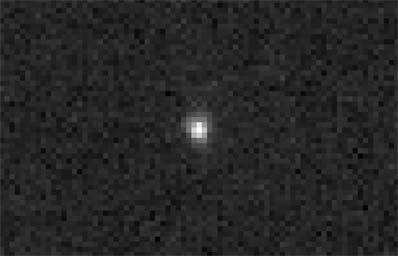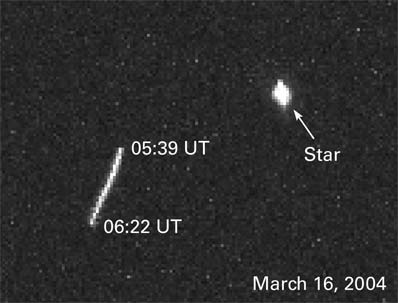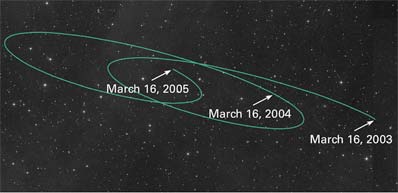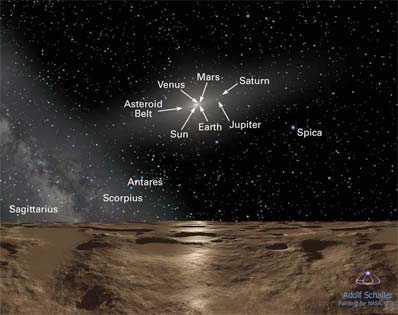Astronomy Picture of the Day
Discover the cosmos! Each day a different image or photograph of our fascinating universe is featured, along with a brief explanation written by a professional astronomer.
Posted on 04/15/2004 3:33:11 AM PDT by petuniasevan
Discover the cosmos! Each day a different image or photograph of our fascinating universe is featured, along with a brief explanation written by a professional astronomer.
Explanation: Venus still rules the western skies after sunset as the brilliant evening star. While wandering the ecliptic with its fellow naked-eye planets earlier this month, it passed near the Pleiades star cluster, providing a striking photo opportunity for earthbound skygazers. Cataloged as M45, the Pleiades stars make for a lovely sight on their own, often shown in long exposure images immersed in hazy blue reflection nebulae. In this picture though, recorded on the evening of April 3rd, brilliant Venus closes with the Seven Sisters and overwhelms the light from the delicate cosmic clouds. The view offers a study in contrasts as Venus appears about 700 times brighter than Alcyone, the Pleiades brightest star. With Venus just over 5 light-minutes from Earth, Alcyone and the other Pleiades cluster stars are about 400 light-years distant. Formed out of the contracting nebula which gave birth to the Sun, Venus is also roughly 4.5 billion years old. The stars of the Pleiades are likely aged a mere hundred million years.
Astronomers poring over 35 NASA Hubble Space Telescope images of the solar system's farthest known object, unofficially named Sedna, are surprised that the object does not appear to have a companion moon of any substantial size.
 At a distance of over 8 billion miles, Sedna is so far away it is reduced to one picture element (pixel) in this image taken in high-resolution mode with Hubble's Advanced Camera for Surveys. Credit: NASA, ESA and M. Brown (Caltech) |
When Sedna's existence was announced on March 15, its discoverer, Mike Brown of Caltech, was so convinced it had a satellite that an artist's concept of Sedna released to the media included a hypothetical moon.
Brown's prediction was based on the fact that Sedna appears to have a very slow rotation that could best be explained by the gravitational tug of a companion object. Almost all other solitary bodies in the solar system complete a spin in a matter of hours.
"I'm completely baffled at the absence of a moon," says Brown. "This is outside the realm of expectation and makes Sedna even more interesting. But I simply don't know what it means."
Immediately following the announcement of the discovery of Sedna, astronomers turned the Hubble Space Telescope toward the new planetoid to search for the expected companion moon. The space-based platform provides the resolving power needed to make such precision measurements in visible light. "Sedna's image isn't stable enough in ground-based telescopes," says Brown.
 Hubble took a total of 35 images of Sedna on March 16, 2004. The planetoid appeared to move slightly between exposures, due to the motion of Hubble around Earth and the motion of the Earth around the Sun. Sedna, too, is moving through space, but too slowly for that to be seen in these images. The fact that the object shows this parallax shift between exposures demonstrates that Sedna is a member of the solar system, and hence is far closer to the Earth than the background star (at right) in the same field of view. Credit: NASA, ESA and M. Brown (Caltech) |
"Despite HST's crisp view (equivalent to trying to see a soccer ball 900 miles away), it still cannot resolve the disk of mysterious Sedna," says Brown. This would place an upper limit in the object's size of being approximately three-quarters the diameter of Pluto, or about 1,000 miles across.
But Brown predicted that a satellite would pop up as a companion "dot" in Hubble's precise view. The object is not there, though there is a very small chance it might have been behind Sedna or transiting in front of it, so that it could not be seen separately from Sedna itself in the Hubble images.
Brown based this prediction on his earlier observations of apparent periodic changes in light reflecting from Sedna's mottled surface. The resulting light curve gives a long rotation period exceeding 20 days (but not greater than 50 days). If true, Sedna would be the slowest rotating object in the solar system after Mercury and Venus, whose slow rotation rates are due to the tidal influence of the Sun.
 A plot of Sedna's apparent motion through space from 2003 to 2005 easily demonstrates that it is close enough to be part of the solar system. The looping path isn't real, but is caused by the fact that Earth is orbiting the Sun and so "laps" Sedna, like a faster race car, once every year. Credit: NASA, ESA and M. Brown (Caltech) |
Small bodies like asteroids and comets typically complete one rotation in a matter of hours. Pluto's rotation has been slowed to a relatively leisurely six-day period because Pluto is tidally locked to the revolution period of its satellite Charon. Hubble easily resolves Pluto and Charon as two separate bodies. NASA's forthcoming James Webb Space Telescope will provide a platform for further high resolution studies of the infrared light from such distant, cold bodies in our solar system.
The Space Telescope Science Institute (STScI) is operated by the Association of Universities for Research in Astronomy, Inc. (AURA), for NASA, under contract with the Goddard Space Flight Center, Greenbelt, MD. The Hubble Space Telescope is a project of international cooperation between NASA and the European Space Agency (ESA).
 Points of interest in artist's view of Sedna. Credit: Credit: NASA and A. Schaller |

YES! You too can be added to the APOD PING list! Just ask!
Disclaimer: Opinions posted on Free Republic are those of the individual posters and do not necessarily represent the opinion of Free Republic or its management. All materials posted herein are protected by copyright law and the exemption for fair use of copyrighted works.